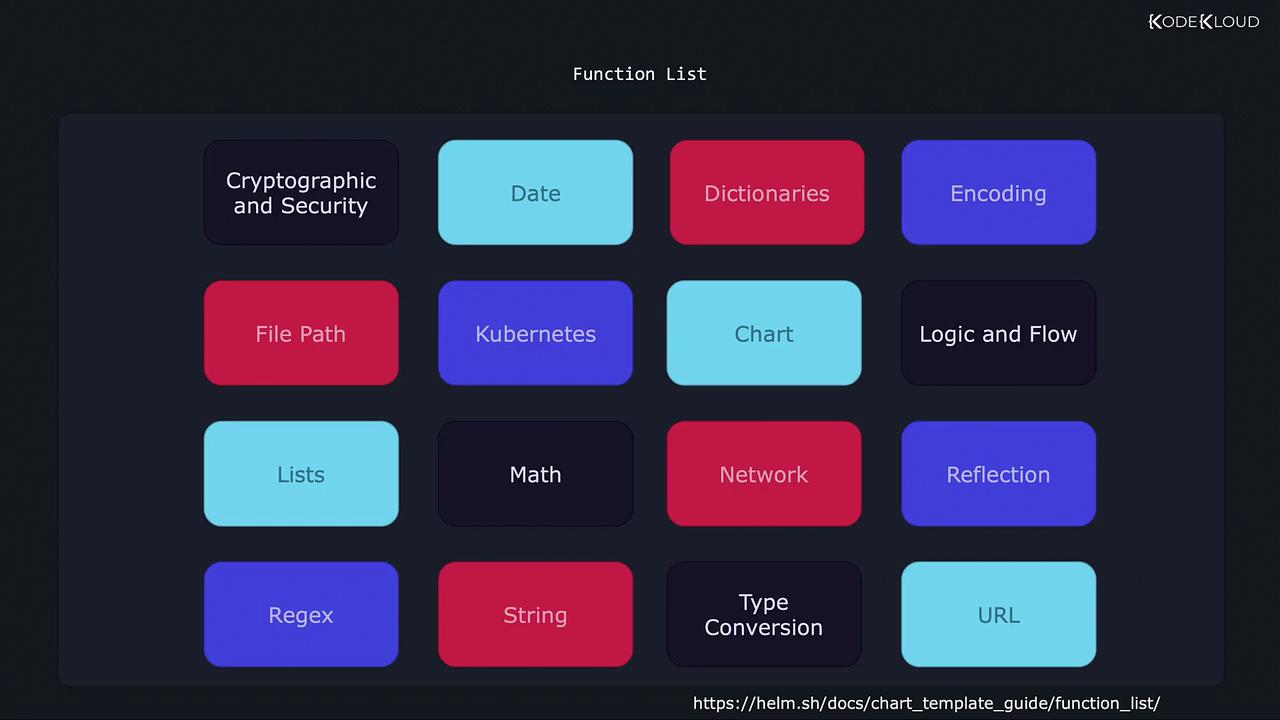Helm for Beginners
Helm Charts Anatomy
Functions
In this lesson, we explore how functions work in Helm and how they can enhance your templating process. When you combine a template with values defined in a values.yaml file, Helm generates a valid manifest file. However, if a field in values.yaml is not set, the corresponding section in the manifest may be omitted. For example, consider the following template:
apiVersion: apps/v1
kind: Deployment
metadata:
name: {{ .Release.Name }}-nginx
spec:
replicas: {{ .Values.replicaCount }}
selector:
matchLabels:
app: hello-world
template:
metadata:
labels:
app: hello-world
spec:
containers:
- name: hello-world
image: {{ .Values.image.repository }}
ports:
- name: http
containerPort: 80
protocol: TCP
And the corresponding values.yaml file:
replicaCount: 2
image:
repository:
pullPolicy: IfNotPresent
tag: "1.16.0"
With these definitions, the generated manifest file will be:
apiVersion: apps/v1
kind: Deployment
metadata:
name: hello-world
spec:
replicas: 2
selector:
matchLabels:
app: hello-world
template:
metadata:
labels:
app: hello-world
spec:
containers:
- name: hello-world
image: nginx
ports:
- name: http
containerPort: 80
protocol: TCP
Warning
If the repository name is not set in values.yaml, the rendered manifest will lack an image value, leading to pod startup failures.
To resolve this issue, the chart can define default values. If the user does not provide a value in values.yaml (or via the command line), Helm can fall back to a default specified using a function. In our example, we want the default image to be "nginx".
Helm Functions Overview
Helm functions behave similarly to those in conventional programming languages: they process an input and return a transformed output. For instance, the upper function converts a string to uppercase, and the trim function removes surrounding whitespace. Consider these examples:
upper("helm") ➞ "HELM"
trim(" helm ") ➞ "helm"
Applied within Helm templates, the value of a parameter can be transformed on the fly. For example, the snippet:
{{ .Values.image.repository }}
renders as:
image: nginx
However, if you wrap the same value with the upper function:
{{ upper .Values.image.repository }}
the output becomes:
image: NGINX
Helm also provides other useful functions like quote (which surrounds a string with quotes) and replace (which substitutes characters within a string). Here are a few examples:
{{ upper .Values.image.repository }}
{{ quote .Values.image.repository }}
{{ replace "x" "y" .Values.image.repository }}
{{ shuffle .Values.image.repository }}
These string manipulation functions are just a subset of what Helm offers. Additional functions cover areas such as cryptography, date handling, dictionary operations, Kubernetes object management, networking, type conversion, regular expressions, and URL handling. For a complete list of supported functions, refer to the official Helm documentation.

Using the Default Function
Revisiting the earlier issue of a missing image repository value: if the value is not supplied in values.yaml or via the command line, the rendered manifest will omit an image, potentially causing a pod to fail. To ensure that your deployment always includes a valid image, use the default function. By specifying a default value (enclosed in quotes to treat it as a string), Helm will use "nginx" if no repository value is provided.
Consider the updated template snippet:
apiVersion: apps/v1
kind: Deployment
metadata:
name: {{ .Release.Name }}-nginx
spec:
replicas: {{ .Values.replicaCount }}
selector:
matchLabels:
app: hello-world
template:
metadata:
labels:
app: hello-world
spec:
containers:
- name: hello-world
image: {{ default "nginx" .Values.image.repository }}
ports:
- name: http
containerPort: 80
protocol: TCP
The values.yaml file remains:
replicaCount: 2
image:
repository: ""
pullPolicy: IfNotPresent
tag: "1.16.0"
With this configuration, if the image repository is not specified, Helm substitutes the default "nginx", resulting in the following manifest:
apiVersion: apps/v1
kind: Deployment
metadata:
name: hello-world
spec:
replicas: 2
selector:
matchLabels:
app: hello-world
template:
metadata:
labels:
app: hello-world
spec:
containers:
- name: hello-world
image: nginx
ports:
- name: http
containerPort: 80
protocol: TCP
Note
Using the default function ensures that your deployments always have a valid image configuration, preventing potential pod failures due to missing settings.
That concludes our discussion on functions in Helm. In the next lesson, we will dive deeper into additional Helm templating features.
Watch Video
Watch video content